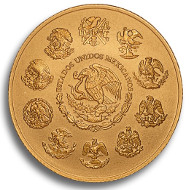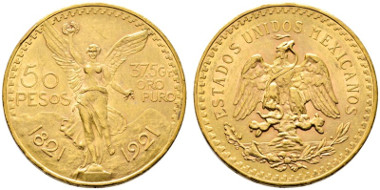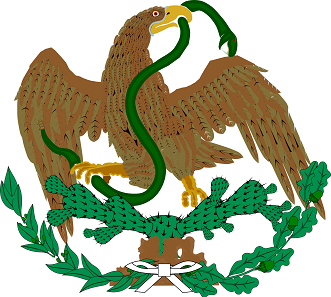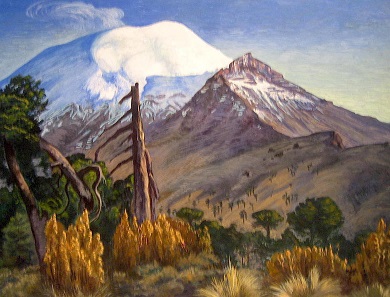translated by Christina Schlögl
Bullion coins from the Mexican mint, the Casa de Moneda de México, their most prominent coin being the Libertad (=liberty), cannot be found in Germany all that often.
The Mexican Libertad, bullion coin from the Mexican mint since 1981. Photo: Degussa.
The Libertad has been on the market since 1981. The Centenario, a Mexican gold coin that was given out on occasion of the 100 year anniversary of Mexican independence, served as paragon for the bullion coin. The Centenario was available as a restrike at the Mexican mint for many years.
The historic model: 50 Pesos 1921, Mexico City. From e-auction Rauch 18 (2015), 1506.
Initially, the Libertad was minted with a fineness of 900, which is mostly the case with historic bullion coins like the Goldmark, and restrikes like guilders or crowns, but seems somewhat outdated for modern bullion coins. Thus the fineness was adjusted to current customs in 1991 and the denominations were extended to include 1/10 ounce and 1/20 ounce coins.
Even though there is no official denomination in the effigy, the Libertad is a legal tender in Mexico, whose value is daily calculated depending on the price for metal.
Coat of arms of Mexico. Eagle sitting on a cactus, growing on a rock emerging from a lake; the eagle is holding a squirming snake in its claws.
The Mexican coat of arms on the obverse
The obverse shows the Mexican coat of arms whose essentials have existed since 1822. It shows an eagle, holding a squirming snake in its beak and claws. It is sat on a cactus that is growing on a rock in a lake. The current coat of arms is depicted in the centre while its historic stages of development are arranged around it in a chronological, clockwise order.
Early depictions of the Mexican heraldic animal from the Codex Mendoza from the middle of the 16th century.
The image goes back to an Aztec legend. The god Huitzilopochtli is said to have told the Aztecs to settle in the place where they would see an eagle holding a snake in its beak and claws. The Aztecs did so and founded the city Tenochtilán, today’s Mexico-City.
The early depictions of this legend make do without the snake, as visible in the Codex Mendoza, which has become the model for the version directly above the central coat of arms.
Mexican coats of arms from the years 1823 until 1864 and 1867 until 1893.
The eagle was connected with the sun god Huitzilopochtli, which was all the more important for the Aztecs when they called themselves the people of the sun. The cactus is called “nochtli” in Nahuatl, which is the language of the Aztecs, and calls to mind the word Tenochtitlán. The snake might thus have snuck into the coat of arms through and error in translation. It was connected with Quetzalcoatl, who might have sanctioned the settling of the Aztecs with the presence of his holy animal. The original text is supposed to have read “the snake hisses”, which then wrongly turned into “the snake is being ripped” in the Spanish translation. The Europeans were too far familiar with this trusted image of the eagle as a symbol of the good and the snake as a symbol of evil to simply let it go.
Amongst heavy traffic, one can spot the angel of Mexican liberty. Photo: Thomas Ledl / CC-BY-SA 4.0.
Victoria or the angel of liberty
The reverse of the coin shows a winged Victoria. In 1996, the original image in which an angel is holding a laurel wreath in its right hand, was newly designed. The wreath is missing and the angle of vision was slightly changed.
The original image is still visible in Mexico-City though, in a roundabout traffic on the heavily frequented Paseo de la Reforma. It depicts the finial of the memorial for the Mexican sovereignty and the battles that had to be fought to achieve it. It was erected on occasion of the centenary of founding of the Mexican state in 1910. A plaque tells us that the memorial is dedicated to the heroes of independence. And indeed the mortal remains of several known freedom fighters, like Guadelupe Victoria, the first president of Mexico, have been lying here since 1925.
They are acknowledged with an eternal flame that has been burning at the foot of the pillar since 1929.
The volcano Popocatépetl with its elevation of 5,452 metres is in close vicinity to Mexico-City as you can see in the painting ‘Vista del Popocatépetl’ by Gerardo Murillo (Dr. Atl), 1934. Photo: Luisalvaz / CC-BY-SA 4.0.
The legend of the great warrior and his white lady
Victoria is placed into a real landscape that is dominated by two volcanoes. It is an area in the immediate surrounding of Mexico-City.
The metropolis is located at the South end of a valley at an average elevation of 2,310 metres above sea level. It is surrounded by mountains on three sides, two of which are the famous twin volcanoes Popocatépetl and Iztaccíhuatl. Their name goes back to an Aztec legend. Popocatépetl (= smoky mountain) is said to have been a brave warrior, who was adored by the daughter of the ruler Iztaccíhuatl (= white lady). When the girl heard rumors that her beloved was killed in the field, she died of grief. Upon arrival, Popocatépetl lay her body on a mountain and stayed there in order guard her, holding a burning torch, until the end of the time.
It is a pretty story, although it does not solely give the inhabitants of Mexico’s capital pleasure. The volcanoes causes recurring problems. Since 21 December 1994, there have repeatedly been incidents of volcanic activity. Sometimes it rains dust, other times rocks, and sometimes streams of lava are even set in motion. The volcano last spewed a 3,000 metre cloud of smoke on 30 October 2016 at 8.57am. It could be only a matter of time until the Popocatépetl causes a catastrophe.
The oldest mint in America
With its founding date of 1535, the mint of the Libertad, the Casa de Moneda de México, is proud to be the oldest mint in America. It was the year when Don Antonio de Mezadona was the first vice king of Spain to ever come to Central America. He had royal order to found a mint on site that should supply the new colony of the Habsburg Empire with money.
Although the minting-process has been relocated to San Luis Potosí in 1983, the headquarters of the mint are still in Mexico-City. Today, the machines from the 19th and the beginning of the 20th century can be viewed at a museum.
Silver variant
A silver variant of the Libertad has been on the market since 1982. At the beginning, only 1-ounce-coins were minted, albeit with a fineness of 999. Since 1991, additional denominations of 1/2, 1/4, 1/10 and 1/20 as well as 2 and 5 ounces and one kilogram coins were gradually introduced.
The current version of the silver Libertad has first been minted in 1996 and its effigy is identical to the gold variant. They are slightly larger in diameter than their predecessor.
Numismatic Data of the Libertad
Coin description:
Obverse: ESTADOS UNIDOS MEXICANOS eagle, holding a squirming snake in its beak and claws, standing on a cactus on a rock emerging from a lake; below: two linked twigs, one oak, one laurel. The scene is surrounded by 10 historic variants of the coat of arms, chronologically organised, starting with the coat of arm directly above the centre image.
The coins of the denominations do not feature the circle of small coats of arms.
Reverse: MEXICO Winged Victoria, slightly turned to the left; behind her: landscape with the two volcanoes Iztaccihuatl and Popocatépetl. Circumscription with indication of weight, ORO PURO, year and fineness. Mint mark in the right field.
– / 1 ounce / 900 / 34.559 g (31.103 g) / 34.50 mm / 2.5 mm
– / 1/2 ounce / 900 / 17.280 g (15.55 g) / 29.00 mm / 1.75 mm
– / 1/4 ounce / 900 / 8.640 g. (7.78 g) / 23.00 mm / 1.40 mm
Since1991, the Libertad is minted with a higher fineness.
– / 1 ounce / 999 / 31.103 g / 34.50 mm / 2.10 mm
– / 1/2 ounce / 999 / 15.55 g / 29.00 mm / 1.75 mm
– / 1/4 ounce / 999 / 7.78 g / 23.00 mm / 1.30 mm
– / 1/10 ounce / 999 / 3.11 g / 16.00 mm / 1.00 mm
– / 1/20 ounce / 999 / 1.55 g / 13.00 mm / 0.85 mm
All episodes of the bullion coins series are available here.
Here you will get to Casa de Moneda de México.
All episodes of the bullion coins series are available here.











